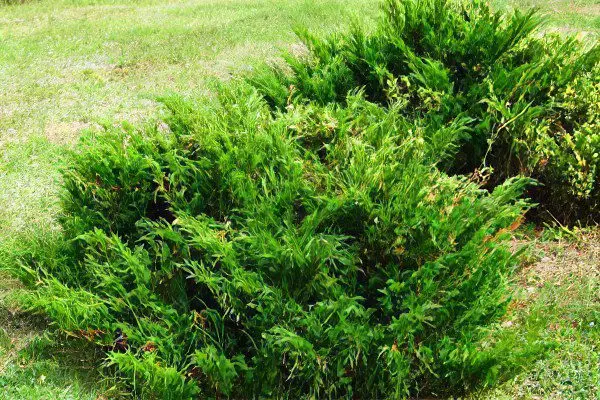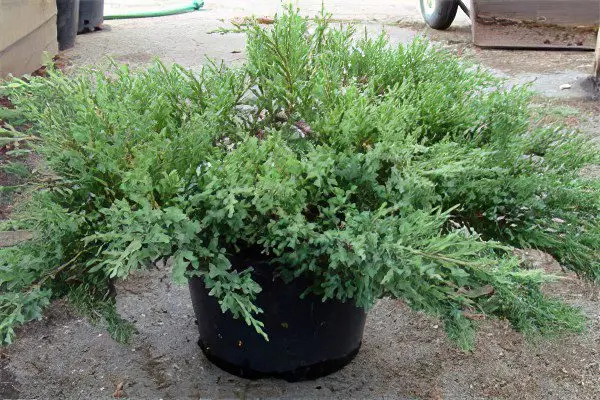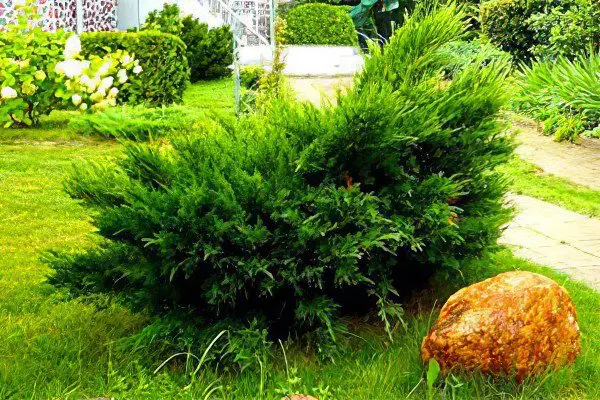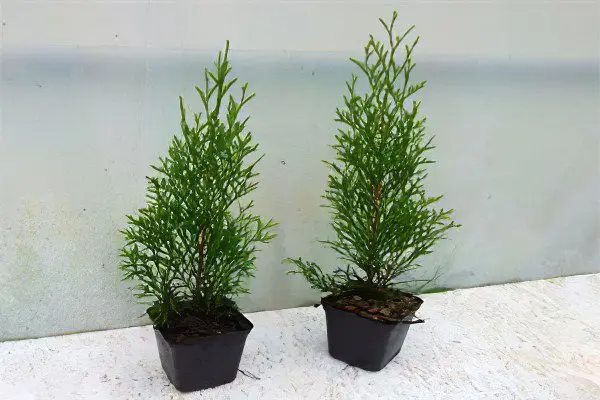Contents

The article describes the Cossack juniper, its main diseases and pests. The possibilities of using the plant in the medical field, in the economy and in landscape design are indicated.
Juniper Cossack is a coniferous shrub belonging to the genus Juniper. In height, the plant does not exceed 1,5 meters. This type of juniper grows very quickly in width and forms dense thickets. The Cossack juniper is also called the Don juniper.
Juniper Cossack can be represented not only by shrubs, but also by trees, but they are rarely found in nature. In height, the tree trunk does not exceed 4 meters, most often it has a curved shape and red-brown bark.
Juniper Cossack is a poisonous plant. The needles of a young shrub have a needle-shaped shape up to 6 mm in length, its color is bluish-green with a median vein. Mature shrubs have scaly needles, it stays on the branches for about 3 years, after which it falls off. The color of adult needles is dark green. The shoots of the plant contain essential oils, so a pungent smell comes from the Cossack juniper from afar.
The Cossack juniper is a dioecious plant, on it cone berries up to 7 mm in size are formed, having a round-oval shape. Coneberries contain two seeds, and a maximum of 4 seeds. They ripen in spring and autumn.
Juniper Cossack does not impose special requirements on the soil, tolerates drought well, has a powerful root system that prevents soil erosion. The shrub loves sunlight, is not sensitive to smoke and gases.
Most often, the plant is found in forests and steppes. The shrub likes to settle on rocks and mountains, as well as on sand dunes. Cossack juniper habitat: Caucasus, Urals, Siberia, Primorye, Southeast Asia, the center of Europe. The average lifespan of a plant is 100 years.
The use of juniper Cossack on the farm

Cossack juniper shoots contain about 5% essential oil. Its pungent smell repels insects, so the branches of the plant are often used to get rid of domestic moths. For this purpose, the branches are laid out in a closet, next to woolen things.
The plant is not used for livestock feed, as all its above-ground parts contain about 17% sabinol. This substance can cause severe poisoning in animals, as well as provoke miscarriages.
As for the wood of the plant, it is very durable, but soft. Wood is easy to process, polish and paint. It is used for both flat-relief and volumetric threads. Products made of Cossack juniper wood do not crack or warp. The roots and branches of the plant are used to make pickling tubs, fishing hooks, milk jugs, beer and kvass mugs.
The use of Cossack juniper in medicine

Since Cossack juniper is a poisonous plant, its use in medicine is very limited. Mostly it is taken externally.
Ointment preparation. An ointment is prepared from juniper, which is applied to the hair for baldness. This remedy is good for dermatological diseases. Ointment lubricates the skin affected by scabies, lichen, scab.
To prepare it, you need to take thoroughly washed leaves, twist them in a meat grinder and squeeze out the juice. Then the juice of the plant is mixed with butter in a ratio of 1: 3 and removed for 12 hours in the refrigerator. The resulting ointment is applied to the affected areas of the skin 2 times a day. The course of treatment is 5 days.
Preparation of infusion. An infusion based on Cossack juniper is used to remove warts. It can also be used for douching with trichomonas colpitis. To prepare the infusion, you need a tablespoon of berries and leaves of the plant. They are poured with 300 ml of boiling water and insisted for an hour. Then the infusion is filtered and lotions are made on the warts. If the remedy is used for douching, then the procedure should be performed 1 time per day, before bedtime. The course of treatment is a week.
Preparation of powder for the treatment of purulent wounds. The powdered form of the plant is used to accelerate the healing of purulent wounds. To do this, dry leaves of the shrub are ground and powdered with purulent ulcers 2 times a day. Due to the powerful antiseptic properties of juniper, the wound will be cleansed of pus after a few days and will begin to heal.
Young shoots with leaves are used in the form of an essence for the treatment of diseases of the kidneys and bladder, for gout, painful menstruation and cycle failures. However, it should be remembered that Cossack juniper is a toxic plant, so it must be used very carefully. Before starting treatment, you should consult with your doctor.
The use of Cossack juniper in landscape design

Landscape designers widely use shrubs to form various compositions. They are decorated with slopes, rocky cliffs. On lawns, group and single planting of juniper is possible.
Often Cossack juniper is used to create rough Scandinavian designs, where rocky spaces, clear boundaries and reasonable restraint prevail.
Junipers with yellow-green needles are combined with mosses, lichens and heathers. They look great with a variety of dwarf shrubs.
Large plants are used to create a cold English design. At the same time, plants of the correct shape and soft color are taken as the basis. Such shrubs are not the center of the composition, but only complement and ennoble the overall landscape. It is possible to use a plant to create a Japanese style. In this case, bushes of a strict form are more suitable.
The content of juniper Cossack in the apartment
Juniper Cossack can be kept at home. As a rule, dwarf shrubs or trees are used for this purpose. The owners of such plants appreciate them for their high fungicidal properties, and not just for their decorative qualities.
Juniper loves sunlight and light soil. Sand, woody soil, peat and lime should be combined in equal proportions. It is not necessary to water the plant often, it is enough to moisten the soil once every 1 weeks, but in the dry season, the frequency of watering should be increased. It is good if in the summer the plant can be taken out to the backyard or to the balcony.
Diseases and pests of Cossack juniper

Juniper Cossack, like other conifers, suffers from pear rust. This fungal disease provokes the formation of growths in the bark and wood of the shrub, which lead to thickening and death of the branches. The disease is practically not treated and becomes chronic. Therefore, when the first signs of rust appear, it is necessary to treat the branches with fungicides. The procedure should be carried out twice with an interval of 2 weeks.
Another disease of the Cossack juniper is biotorella cancer. This is a fungal infection that provokes necrosis of the tree bark. To combat the disease, a 1% solution of copper sulfate is used. After that, the wounds are treated with garden pitch or oil paint. All diseased branches are removed and burned.
The root system of the Cossack juniper is often affected by spore fungi, causing a disease called fusarium. At the same time, the plant ceases to receive nutrients from the soil, its needles begin to turn yellow, then turn red and crumble. Gradually, the entire shrub dries out and dies. In order to prevent the development of the disease, it is necessary to abandon planting the plant on putrefactive soils, in areas with insufficient lighting and with stagnant water. For prophylactic purposes, you can use the solution “Baktofit” in which the juniper root system is soaked.
At the same time, the Cossack juniper is not afraid of insects, since the pungent smell emanating from it repels most pests.









